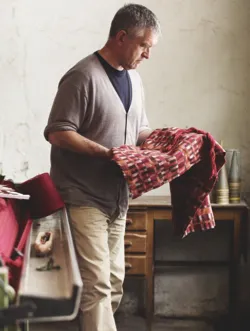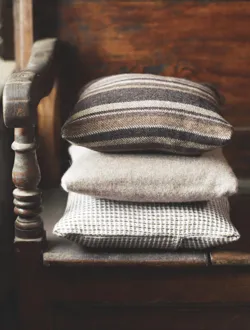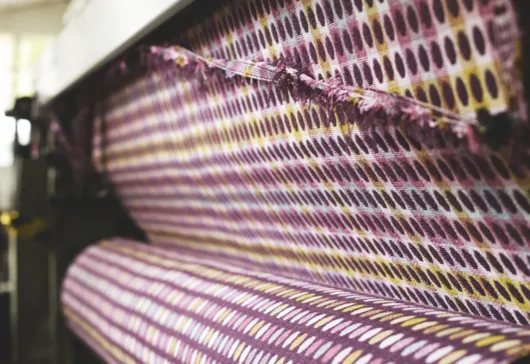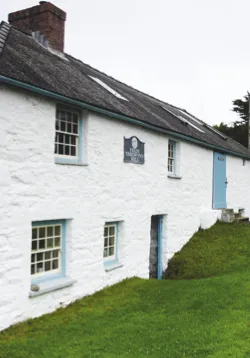There can be few more blissfully located workplaces than the Welsh woollen mill Melin Tregwynt. Tucked away in a remote corner of Pembrokeshire, it sits flanked by a stream on one side and a hill on the other. Small whitewashed buildings are scattered over the site of the former farm and at its core is the mill, producing rolls and rolls of on-trend weaves, feted by cutting-edge interiors aficionados and traditionalists alike.
Eifion Griffiths is the third generation at the helm of what has been a family business for a century. With his wife Amanda and team of 20-plus, he is pushing the company ever onwards. While the weaving process has altered little over the years, where and what they sell has.
‘In my grandfather’s time, flannel was the main fabric produced in Wales,’ says Eifion. ‘It’s inflammable and so was used to make shirts for the army, as well as for coal and steel workers. The market was huge and then it started to decline. Wales has gone from hundreds of mills to just five or six.’

As a result, Melin Tregwynt has carved its own unique niche – mixing time-honoured weaving techniques with design nous to produce a small but covetable array of beautifully-made throws, blankets and cushions and now upholstery fabrics in a capsule range of designs.
Best known are the distinctive spots of ‘Mondo’ as well as ‘Madison’, another trademark fabric featuring a retro-inspired geometric pattern influenced by a lime-green maxi skirt that Eifion’s mother used to wear. ‘She was going to chuck it out but I asked if we could hang on to it as the design is interesting. We re-coloured it and designed it a little bit differently. I thought we’d probably produce it for a couple of years. That was at about 15 years ago.’
Wool in every shade
Any tour of the mill starts with the room that houses the water wheel, once the mill’s source of power. It is now virtually defunct and the room is used to store vibrant-coloured wool in every shade, piled up in wooden storage boxes. ‘In my grandfather’s day they used to dye the wool in a boiler,’ says Eifion. ‘You can imagine the river would have been a different colour every day. That’s something you just can’t do nowadays!’
Instead, they source their lambswool from New Zealand, via a British supplier. ‘I’d love to point at our wool and say, “It’s all come from the UK,” but we need to use lambswool and it’s a climate thing – British wool is too coarse for our work.’

Go through a door by the waterwheel and you’re among the clattering looms in the weaving room where the wool is loaded onto creels (frameworks for holding bobbins) and the shafts rise and fall quickly and noisily to turn out 300m of cloth a week.
It then goes to quality control, aka Jean Devonald, who mends any breaks in the thread and unpicks knots before the fabric is sent off for finishing. On its return – degreased, washed and fluffed – it sits in a converted cattle shed, waiting to be plucked from the shelves to be sewn on site.
Bright rolls of checks jostle with plains, spots, squares, folksy weaves and a range of one-offs that the mill has produced with interiors retailers such as the Shaker Shop, SCP and, more unusually, Waitrose, in 2008, who wanted to source the largest picnic blanket in the world for an ad campaign.
‘It was about 40 by 45m. We sent off 20 huge rolls of cloth to South Africa where they used a sail-maker to stitch the rug together. It weighed a ton and took 30 men to carry it. I think it’s still in the Guinness Book of Records.’

A riot of throws
Eifion was brought up at the mill and recalls his father’s first attempt to convert the family sitting room into a shop, to appeal to the growing number of tourists in Pembrokeshire. ‘I remember wondering who on earth these people were in my home!’ Eifion remembers. It proved so successful that a standalone shop was built, which now houses a riot of floor-to-ceiling woollen throws, blankets, cushions and jackets.
The mill wasn’t Eifion’s initial calling. He trained as an architect. ‘But I realised that there is a tradition here that was in danger of being lost,’ he says. So he returned in 1979 and threw himself into the business, opening up new markets and imbuing the brand with a certain hipness.
He realised along the way that architecture and weave had a lot in common. ‘They’re intrinsically linked. It’s to do with small structures that make larger structures. I find that exciting. I’m here, of course, because it’s a family thing, but I’m lucky to enjoy what I’m doing.

Despite the fashion cachet of his ranges, Eifion is passionate about preserving tradition in its production. ‘We want to keep the skills. When I first came back it felt like a dying business and what skills there were were historic skills. That’s not true now. We have a lot of young people and we’re relatively flexible about how people work for us so we get really good quality people. I’m amazed at the talent we have sometimes.’
They must be doing something right as they have skirted the recession relatively painlessly, adding ever-increasing numbers of boutique hotels to their client base, and the mill is now supplying John Lewis, which has added bulk to its production. And, of course, there has been a recent sea change in attitude with consumers favouring quality over quantity and buying British made, all of which can only be good for a company like Melin Tregwynt.
‘There was a time where you almost had to apologise for making in the UK, whereas these days people are much more positive,’ says Eifion. Thank goodness.
Feature: Angela Linforth
Photographs: Andrew Montgomery